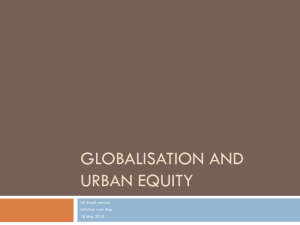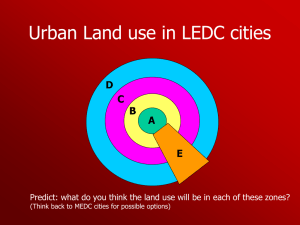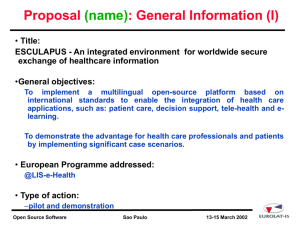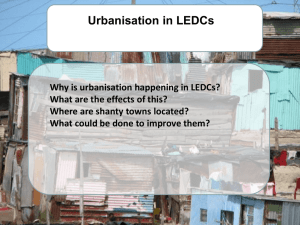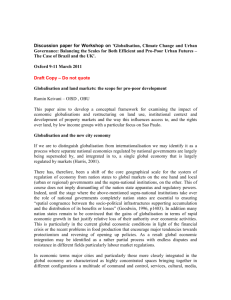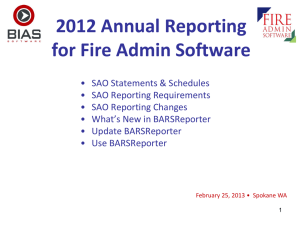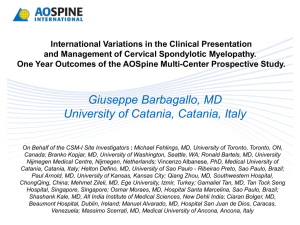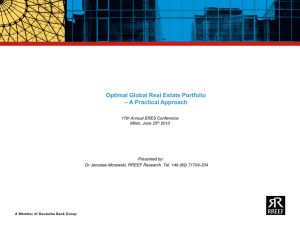Scope for pro-poor development
advertisement
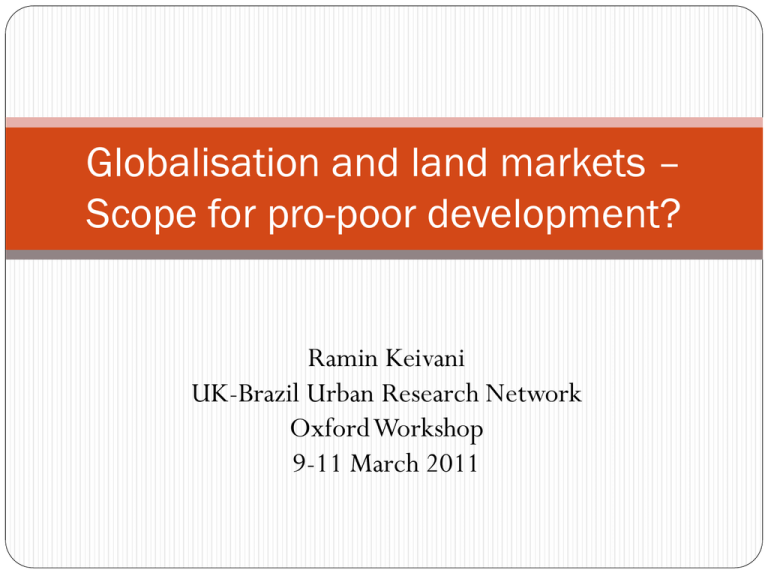
Globalisation and land markets – Scope for pro-poor development? Ramin Keivani UK-Brazil Urban Research Network Oxford Workshop 9-11 March 2011 Main Research questions • • • • • • • • What are the main characteristics, drivers and limitations of the initiative under consideration? How do these initiatives relate to the main concern of this network for enabling governance for sustainable and flexible urban futures? Does governance actually matter in the success or failure of these initiatives? If it does then what are the emerging forms and patterns of governance that are most effective for developing and implementing policies for economic growth, environmental sustainability, social inclusion and poverty alleviation? What other actions or interventions can governments (at different levels), private sector and civil society actors make to facilitate more sustainable and flexible urban futures in the fields under consideration? What are the key transferable or informative lessons for consideration across each country? What are the conceptual and theoretical insights that can be drawn from exploring these issues across both countries? What are the key issues in each field that would need to be developed as part of a broader research agenda for addressing the main objectives of this network? Globalisation: What does it entail? Implies that a world composed of separate national economies is being superseded by a single global economy, States by global markets – countries/cities become junctions in flows that governments have less control Uneven development Path dependent Macro economic effects Deregulation, liberalisation, sectoral shifts New city economy as junctions of flow Pervasive effects in the North and South Impact on urban form and property1 • City development reoriented in line with spatial requirements of international capital – Occupier demand • Intensified redevelopment of Central Business Districts, creation of new CBDs – Three CBDs in Sao Paulo! – State of art office space with global connection • Globally connected industrial estates • Retail, leisure and hospitality facilities • Housing – Investment demand • Core and opportunistic investment depending on: – Institutional risks » Property laws and regulations, professional services, contract enforcement, etc – Market risk » Interest rates, recession, wars, political stability, economic growth, etc Total investible and invested real estate by region in 2009 (RREEF, 2010a) Impact on urban form and property2 Encroachment on cheaper peripheral land Particularly for industrial development and upper middle class housing Formation of extended metropolitan regions and even larger mega urban regions E.g., Macro Greater Region of Sao Paulo Blurring of rural and urban dichotomy, shifting industrial activities to peri-urban and rural areas, agglomeration economies, etc. Restructuring city economies and resultant spatial reconfiguration and redevelopment All of this means major investment in real estate both as a direct result of global investment diversification strategies and indirect result of (globally induced) development activities But what about Brazil and Sao Paulo? Sao Paulo: an emerging global city!? • Widely recognised as the main gateway to Brazil and the centre of • • • • Brazilian economic growth producing 34% of national GDP Service and Finance sector 47% of state GDP Industrial sector still highly important at 46% of state GDP Transition to a high value global function is still incomplete but the trend is one of gradual de-industrialisation and development as a HQ and service centre for Brazil and the Mercosur Region Booming Real Estate market from both international and local demand – Mortgage lending doubled to $42 billion between 2009 and 2010 – Attracting large scale and individual international investors – Emergence of a large number of real estate funds for indirect investment across different sectors targeted at International investors Global Network Connectivity 175 firms – 526 cities (Pain, 2009) Rank GNC 2008 1 London 100 8 Shanghai 69.74 12 Seoul 63.5 16 Buenos Aires 61.19 17 Mumbai 60.86 18 Kuala Lumpur 59.72 19 Warsaw 56.4 20 Sao Paulo 56.19 2000 16 Sao Paulo 54.74 23 Buenos Aires 44.56 Latin America 2009 commercial property investment activity (RREEF, 2010b) Global real estate market value in 2009 (RREEF, 2010a) Globalisation and its urban discontents Globally driven economic and spatial restructuring can severely aggravate pre-existing social inequalities and create new ones! School of the Built Environment Looking at the problem from another perspective 26% of MRSP live in Favelas and illegal settlements Rising to 43% in peripheral areas Overall 70% of land in the city is covered by substandard housing Affecting 57% of MSP population School of the Built Environment Demographic shifts in Sao Paulo (Torres et al, 2007) Increasing population in peri-urban areas to 30% by 2000 8.1% annual increase in these areas -2.5% negative growth in central areas Rapid urban sprawl in Sao Paulo (Torres et al, 2007) Distribution of real estate projects (Torres et al, 2007) Formal development companies housing only 23% of additional households during 1990s Peripheral areas dominated by self built low income housing 620000 abandoned buildings in the centre more than estimated housing deficit in MRSP!? A complex and contested spatial geography (UN-Habitat, 2010) • City of walled estates intermingled with favelas • Conflict with developers over valuable central land • Driving the poor out: the case of jardim edite a ZEIS designated area that did not work as planned • Dynamics of the formal property market driving urban sprawl and reinforcing social and spatial segregation!? But what are the opportunities for the low income population? Economic readjustments in peripheral/peri-urban areas and connections to the main formal economy, e.g., informal workshops and service sector activities supporting formal sector The role of land and property as assets for income generation, Home-based enterprises Institutional constraints Property rights: tenure, development, use and exchange School of the Built Environment Towards an analytical Framework The role of urban governance1 A definition: Broader than government entailing the process of interaction between the public sector and various actors and groups of actors in civil society Crucial to this are power relations and interactions between agents that determine management and allocation of resources particularly access to and use of land School of the Built Environment The role of urban governance2 • Devas (2001) identifies the necessity for congruence of three critical factors: – inclusive political process – sufficient competence and capacity of city governance institutions – pressure from civil society • Globalisation creates particular conditions that have direct and specific consequences on all of the above, • But what are the possibilities for new forms of governance that can be more responsive to future equity challenges? School of the Built Environment Developing an institutional understanding of land markets • In terms of NIE impact of transaction costs and institutional constraints – costs of negotiating and completing transactions – Formal and informal rules and social structures for facilitating and organising interests of actors and enforcing principal/agent relationships • From a more sociological perspective complex articulation between structure and agency that must be seen within the wider debate on social production of space Capital Asset Framework Increasing low income capabilities to accumulate assets and remove obstacles to its productive use This would mean ability to use, earn income from and exchange property But does it mean increasing formal property rights or rights over property? To answer this we must understand not only informal property processes but also the social value of land and property for the poor. What about the Brazilian context? • An array of national, state and municipal level institutional innovations for more equitable growth: – The statute of the City has provided the scope for greater socialisation of development benefits: – Zones of special Social interests – Participatory planning – Etc… • But what has been the effect on the ground? – How have the institutional and governance arrangements impacted the implementation? – Are good laws/institutions sufficient? – What are the limits of participatory governance? How can we create the conditions for effective implementation to balance differentials powers for influencing decision making in a contested terrain? • What type of institutional arrangements and implementation mechanisms on property rights are best suited for enhancing low income capacity to benefit from land development? Key areas for a future research agenda Forms and processes of urban governance on land use and property development Institutional context of formal property market and underlying drivers for social production of space Informal market processes Interface of formal and informal markets particularly in terms of how the former is impacting the latter The scope for low income asset consolidation and capital accumulation Thank you References Devas, N. (2001) Does city governance matter for the urban poor, International Planning Studies, 6(4), 393–408. Paine, K (2009) Londres – The place to be, Sciences Humaines, Les Grands Dossiers, 17. RREEF (2010a) Global real estate insights 2010, RREEF London, www.rreef.com RREEF (2010b) Latin American real estate markets in perspective, RREEF San Francisco, www.rreef.com Torres, H, Homberto, A and De Oliveira, M.A (2007) Sao APulo peri-urban dynamics, Environment and Urbanization, 19, 207-223. UN-Habitat (2010) Sao Paulo: a tale of two cities, http://www.unhabitat.org/pmss/listItemDetails.aspx?publicationID=2924
